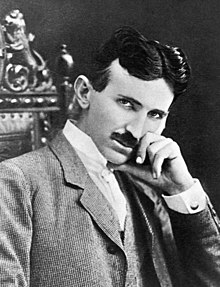 If you have been to Zwanger-Pesiri Radiology for an MRI (magnetic resonance imaging) scan, you know that we use state-of-the art equipment, including 3.0 Tesla and 1.5 Tesla MRI.
If you have been to Zwanger-Pesiri Radiology for an MRI (magnetic resonance imaging) scan, you know that we use state-of-the art equipment, including 3.0 Tesla and 1.5 Tesla MRI.But perhaps you've wondered what, exactly, is a "Tesla?"
Tesla is a unit of measurement of magnetism. To give you an idea of the strength of a tesla magnetic field, let's use the example of a refrigerator magnet. A strong refrigerator magnet is 100 gauss (another unit of magnetic field). It takes 10,000 gauss to equal 1 tesla, so it's a very strong magnet indeed! But how did it get its name?
The tesla magnetic unit was named after the scientist and inventor, Nikola Tesla. Tesla was a strange and interesting man -- the epitome of "brilliant mad scientist." He was born in 1856 in what is now Croatia. In 1884, he moved to New York City. He began working for Thomas Edison's company, which was building direct current (DC) generators. Within a few short years, Tesla had a falling out with Edison and started his own company which developed an alternating current (AC) motor based on a rotating magnetic field. Tesla sold his invention to George Westinghouse. What followed, for many years, was a war between inventors about which type of energy was better -- Edison's DC or Tesla's (Westinghouse) AC.
 It wasn't just electricity that Tesla dabbled in. He experimented with X-rays, which had only just been discovered. In fact, one of the earliest X-ray photographs in existence is one of Tesla's hands! (See image at left). Tesla also experimented with radio waves and created radio-controlled devices (later used for military purposes). Tesla's dream was to create a system to transmit electrical energy wirelessly through the air, but this never came to fruition. Tesla was also the inventor of the spark plug for gasoline engines. This was just one of his close to 300 patents worldwide.
It wasn't just electricity that Tesla dabbled in. He experimented with X-rays, which had only just been discovered. In fact, one of the earliest X-ray photographs in existence is one of Tesla's hands! (See image at left). Tesla also experimented with radio waves and created radio-controlled devices (later used for military purposes). Tesla's dream was to create a system to transmit electrical energy wirelessly through the air, but this never came to fruition. Tesla was also the inventor of the spark plug for gasoline engines. This was just one of his close to 300 patents worldwide.Tesla was a genius, with a photographic memory, who claimed to sleep no more than two hours per night. He never married and claimed that chastity helped his scientific abilities. Mark Twain was a close friend, as was the architect, Stanford White. It was thought that Tesla had obsessive compulsive disorder (OCD) -- he developed a hatred of jewelry and round objects, refused to shake hands, could not bear to touch hair, and became obsessed with the number three. He loved pigeons, and would bring injured ones back to his hotel room to heal. He later claimed to have fallen in love with one particular pigeon and that he "loved that pigeon as a man loves a woman." He moved to the Hotel New Yorker in 1934, where he lived until his death in 1943 at age 86. He was eulogized by NY Mayor, Fiorello LaGuardia.
In 1960, in honor of Nikola Tesla, the General Conference on Weights and Measures dedicated the term "tesla" as a unit measure of magnetic field strength. But that's not the only thing that has been named after him. In addition to a unit of magnetic force, Tesla is also the name of an electric car company, a minor planet, the largest power plant in Serbia, a crater on the far side of the moon, an airport in Belgrade, and a rock band!
To learn more about Nikola Tesla, visit http://www.pbs.org/tesla/index.html


